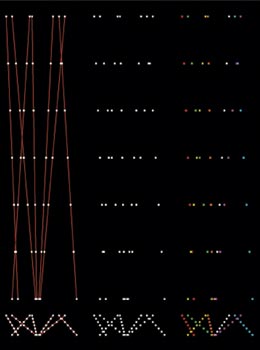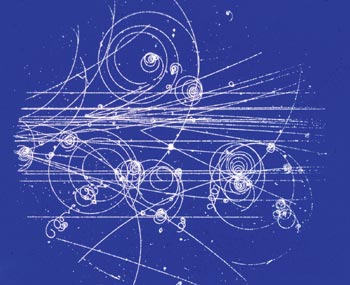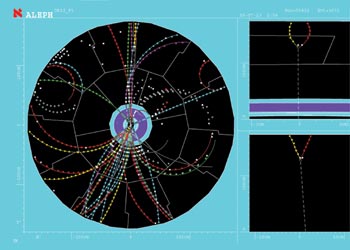Handling, presenting and understanding the complex track patterns produced in the collisions of high-energy particles calls for considerable ingenuity. Gordon Fraser talks to CERN collision display specialist Hans Drevermann.

Physics is the study of natural phenomena by humans equipped with brains. Without humans there would still be nature, but without brains there would be no understanding. The mechanisms of the brain therefore have a direct bearing on the way we see physics.
The brain is equipped with memory and various levels of processing for the data from readout systems linked to delicate sensory organs such as the eyes and ears. Through these sensors, the brain is subjected to a stream of confusing input. Consciousness is the process of interpreting and making sense of all this data.
The brain becomes conditioned to recognize certain signals as being important, and rejects the rest. A baby soon learns to differentiate the image of its mother’s face from the surrounding visual clutter. Later, it learns how to filter language from unresolved noise, and later still, to recognize the systematic shapes of written words. On encountering a word for the first time, the brain must absorb it letter by letter, and then work out what the new word means. Once learned, words are no longer read letter by letter. Instead, the brain directly perceives the pattern of the whole word. Such pattern recognition is a much faster process, but can be error-prone, as anyone who has proofread a document will have discovered.
Modern computers can process basic information much faster than any human brain. However, computers have yet to match the brain’s remarkable ability to perceive and recognize patterns and make judgements. (An example of this ability is given by caricatures, in which a well known face is immediately recognizable from a rudimentary sketch that exaggerates key features.)
Making the invisible visible

Quantum physics underlies the rest of physics, but it is very different to everyday experience. One way of sidestepping this difficulty is the technique of particle tracking. The elementary particles taking part in a collision are themselves invisible, but if the collision is suitably choreographed, its results can be reconstructed.
One of the first tracking detectors was the cloud chamber, which was developed by C T R Wilson, and with which Patrick Blackett dramatically revealed the splendour of a subatomic collision process at Cambridge in the 1920s. A cloud chamber is filled with gas or vapour made metastable by a sudden expansion. A charged particle passing through the chamber rips electrons from the gas atoms, and the resulting ionization causes local condensation, leaving a visible trail behind the particle, just as a high-flying aeroplane leaves a white vapour trail in its wake.
From bubbles to electronics

Cloud chambers worked very well when physicists studied cosmic rays or used low-energy, low-intensity laboratory sources of particles, such as radioactive nuclei. However, cloud chambers were ill-suited to recording nuclear collisions using beams supplied by the post-Second World War high-energy accelerators.
The invention of the bubble chamber by Donald Glaser in 1952 rose to the new challenge. This chamber used a liquid target, rather than gas, offering a proportionally denser obstacle to particle beams. It could also be made larger. Many generations of research physicists explored elementary particles via this route, and glorious photographs of particle interactions gave a fresh view of an otherwise invisible world. The bubble chamber did for the physics of the microworld what the Hubble Space Telescope is doing for astronomy.
However, the graphic images provided by bubble chambers brought new problems. The main one was that there were far too many pictures. Researchers had to carefully sort through millions of photographs from bubble chamber exposures to find what was new.
Experience taught researchers how to project the photographs onto a horizontal table where they could be viewed from different angles (particularly at grazing incidence) to reveal tracks and details that did not show up initially. Electronic instruments were developed to digitize and analyse bubble chamber information, but the pattern recognition abilities of the human eye remained unsurpassed.
About 20 years ago, the advent of high-intensity beams and fast electronics eventually led to new detector techniques and to the demise of the bubble chamber. Information on particle trajectories from today’s colliding beam machines is now recorded electronically. This has the immediate advantage of being partly 3D, and also enables the detector to be “triggered” for special physics situations. A bubble chamber could be compared to a TV camera monitoring traffic at a busy junction. This is useful for general information, but not for spotting speeding cars. For this, a radar gun monitors all passing cars, but only triggers the camera if the car is speeding.
With digital information, the door was also open to automatic pattern recognition, in which a computer could be “taught” to recognize a particular kind of behaviour. Without fast-tracking the analysis in this way, discoveries would become unacceptably rare.

In a big particle detector like ALEPH at CERN’s LEP electron-positron collider, the tracking is carried out in a central cylinder surrounding the point where the particles collide. The remainder of the detector picks up supplementary information (notably energy), differentiates between different kinds of particles, and monitors penetrating muons as they exit the apparatus. Such an electronic detector records discrete hits in successive planes of sensors, and these hits have to be analysed to build up a complete picture of the collision event. (In the same way, a TV image is built up of separate pixels, but from a distance the image looks continuous.)
A track reconstruction procedure helps to reveal trajectories. Because of the number and complexity of the collisions, this track reconstruction must be done by computer. It must also be done accurately and reliably. If only a few collisions are being selected for the fast-tracked “discovery lane”, each one must be exactly right.
An approach pioneered by Hans Drevermann at the ALEPH experiment uses special techniques to check the findings of the track reconstruction procedures. The “Dali” system provides a new generation of classic pictures of electronically recorded particle tracks that rival those of the bubble chamber era. To achieve this, colour and projection, as well as sheer ingenuity, play important roles. The result is an intuitively appealing way of presenting the collisions, which is invaluable for illustrating talks and physics publications.

Dali uses a number of visual tricks to enhance track visibility. One is a “fish-eye” view which artificially “inflates” the central tracking region compared with the rest of the detector. Other Dali techniques involve unconventional transformations of radial co-ordinates that help reveal momentum and direction of track curvature (thereby giving a handle on what kind of particle is involved). In this work, the use of colour has developed into an art form.
Tracking is not the only aspect of recording and interpreting what happens in a collision process. After passing through the central tracker, the emerging particles deposit energy in calorimeters. These are cellular, and the deposited energy is usually spread over a number of adjacent cells. This too has to be displayed.
Together, these imaging ideas have provided a new standard for displaying particle collisions. As well as aiding actual physics analysis, these displays provide a “trademark” presentation of results at meetings and conferences, where images that are immediately recognizable and intuitively understandable are at a great advantage. They also help the physicist to perceive and understand what he is studying. The experience gained over more than 10 years with the ALEPH event display system will now be harnessed for the next generation of CERN experiments at the Large Hadron Collider.





